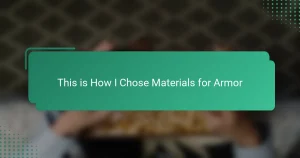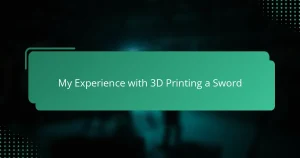Key takeaways
- Crafting science fiction props, like phasers, involves a blend of creativity and storytelling, allowing the creator to connect deeply with their imagination and the narrative.
- Design elements such as ergonomics, color, and lighting significantly influence how a prop is perceived, enhancing its believability and appeal.
- The choice of materials and attention to small details, like hardware pieces, can transform a prop from ordinary to extraordinary, adding authenticity and tactile feedback.
- Personalization through unique designs, colors, and lighting effects allows for a deeper connection between the creator and the crafted piece, making it a reflection of one’s artistic vision.

Introduction to Science Fiction Props
Science fiction props have always fascinated me because they bring imaginary worlds closer to reality. Have you ever wondered how a simple object can transform an entire scene, making the unbelievable seem possible? For me, crafting these props is like breathing life into stories that once lived only in my imagination.
When I first started exploring science fiction props, I was amazed at the amount of creativity and detail involved. Each prop carries its own story, reflecting both the universe it belongs to and the maker’s passion. It’s this blend of art and storytelling that makes working with these items so deeply satisfying.
What makes science fiction props truly special, in my experience, is their ability to spark curiosity and wonder—not just in the audience, but in the creator as well. Every time I hold a prop I’ve made, I feel connected to a larger narrative, one filled with possibility and adventure. Don’t you think that’s what makes science fiction so enduring?
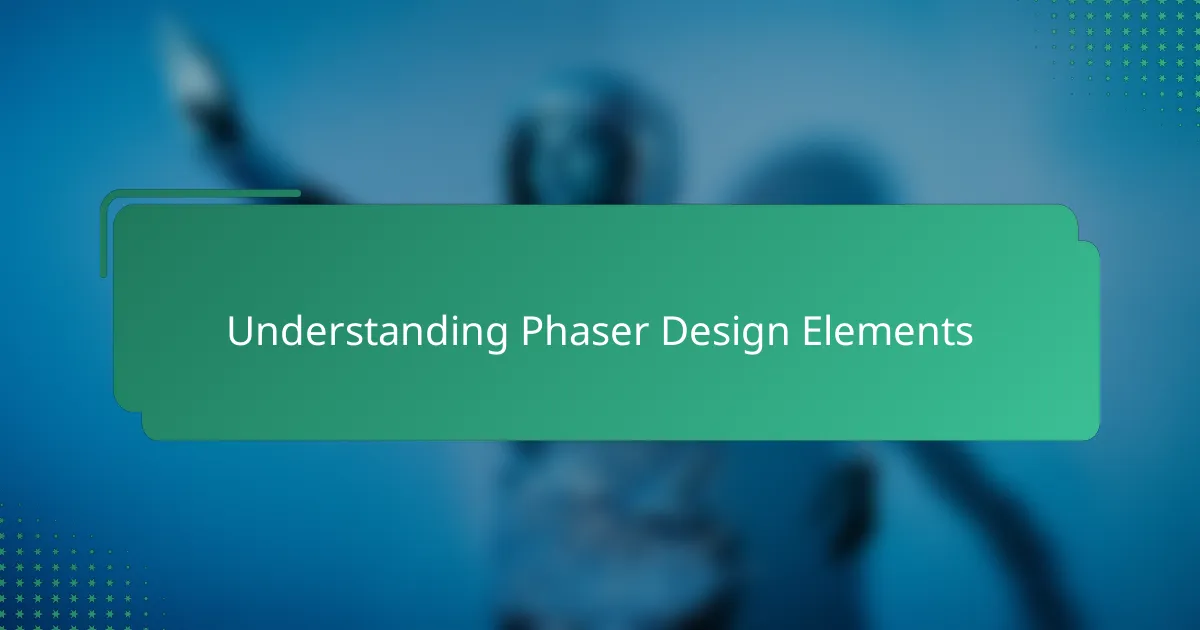
Understanding Phaser Design Elements
When I began dissecting phaser designs, I realized their look isn’t random; it’s packed with intentional elements that blend function and style. Every curve, button, and light serves a purpose, whether it’s conveying futuristic technology or suggesting ergonomic use. This balance between utility and aesthetics is what hooked me—I wanted to replicate that feeling in my own custom phaser.
One detail that stood out was the emphasis on sleek lines combined with tactile details. In many designs, I noticed how subtle grooves or ridges guided the hand naturally, making the prop feel believable. It made me wonder: how could I translate that subtle ergonomics into my build without overcomplicating the design? In my experience, getting this right creates a connection between the user and the device that goes beyond simple appearance.
Color and light are another crucial aspect that I found captivating. The way glowing elements or shimmering metallic finishes highlight certain parts can instantly communicate power or danger. When I planned my phaser, I asked myself how to use these elements effectively to create that immediate visual impact. Reflecting on this, I think these design choices are why so many sci-fi props stay etched in our minds long after the story ends.
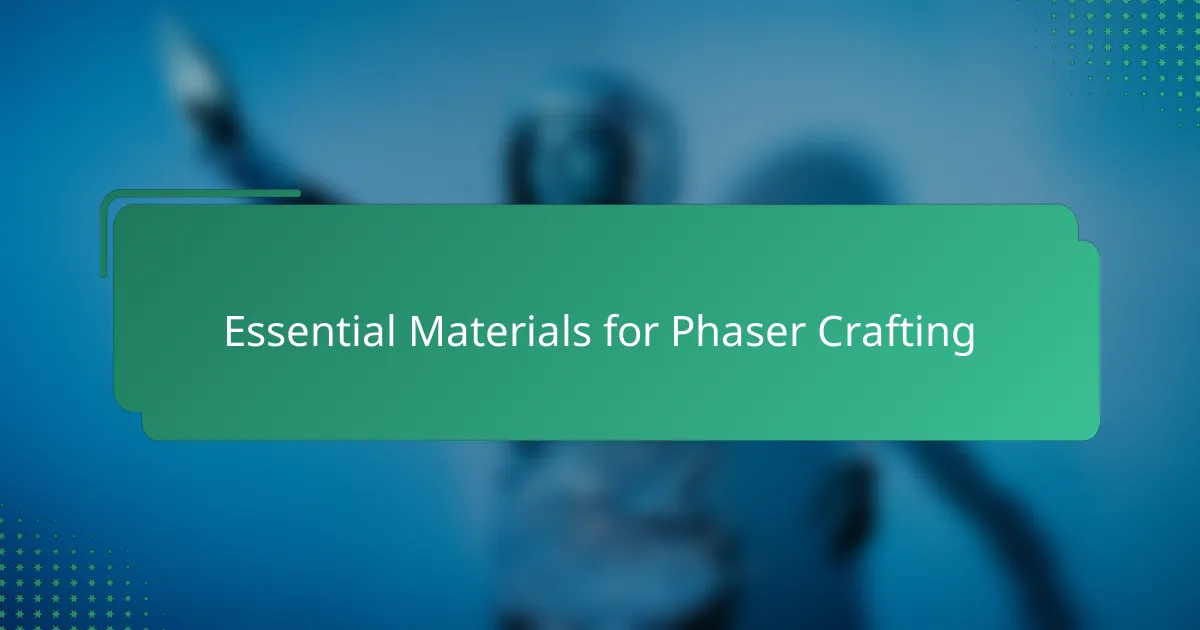
Essential Materials for Phaser Crafting
To bring a phaser to life, I quickly learned that choosing the right materials is just as important as nailing the design. For me, lightweight plastics like ABS or acrylic became essential because they’re easy to shape and durable enough to withstand the countless test fits and paint layers. Have you ever struggled with a material that felt too flimsy or too heavy? That balance makes all the difference.
I also realized early on that you can’t ignore the power of small hardware pieces—buttons, switches, and tiny screws—which add authenticity and tactile feedback. Sourcing these parts from old electronics gave me that satisfying click and texture, making the phaser feel more “real” in hand. Isn’t it amazing how the smallest details can transform a prop from good to unforgettable?
Finally, no phaser would be complete without the right finishing touches: metallic paints, LED lights, and translucent resins. I found experimenting with different paint finishes—matte, gloss, even weathering—helped me capture that futuristic yet worn-in look I craved. Lighting, especially, brought the prop to another level, casting subtle glows that made the build truly pop. Have you ever caught yourself staring at a tiny flicker of light and suddenly believing the prop could actually fire? That’s the magic materials bring to the table.

Step by Step Phaser Construction
The first step in building my custom phaser was creating a sturdy base frame. I chose to carve the main body from a solid block of lightweight plastic, carefully measuring each curve to match the blueprint I had drafted. Have you ever felt that thrill when rough shapes begin to emerge from raw material? For me, it was like watching my imagination take physical form for the first time.
Next came the intricate assembly of buttons, switches, and faceplates. This part demanded patience and precision, especially when fitting tiny screws and electronic components that needed to click just right. I remember spending hours tweaking these details—because nothing beats the feeling of pressing a button and hearing that authentic, satisfying sound. Don’t you think those little touches make all the difference between a prop and a piece of art?
Finally, the entire phaser was coated with multiple layers of paint and sealed with subtle lighting effects. Experimenting with metallic finishes and embedding mini LEDs wasn’t just about aesthetics—it was about capturing that signature sci-fi vibe that makes a phaser instantly recognizable. Seeing the glow shimmer through translucent resin gave me a moment of pure satisfaction, as if the prop had finally come to life. Isn’t it amazing how light can transform something static into something alive?

Customizing the Phaser Appearance
Customizing the phaser’s appearance was where I really got to inject my own personality into the build. Instead of sticking strictly to existing designs, I experimented with unusual color palettes and finishes that felt fresh yet believable. Have you ever found that one unexpected shade or texture that suddenly makes the whole piece pop? That moment always feels like a small victory to me.
Adding details like custom engravings and unique grip textures turned out to be far more satisfying than I anticipated. I remember tracing my fingers over those tiny ridges during late-night painting sessions, feeling that deeper connection to my creation with every stroke. It made me realize how much these subtle touches can turn a simple prop into something truly special.
Lighting effects also played a surprisingly big role in customizing the look. Instead of just standard LEDs, I opted for a softer glow that shifted slightly in intensity—almost like the phaser was ‘breathing.’ Have you ever thought about how light not only illuminates but also tells a story? For me, that slow fade gave the prop a hint of life that transformed the whole piece from static plastic to a believable sci-fi artifact.

Testing and Functionality Tips
Testing my custom phaser was an eye-opener. I quickly learned that consistent button responsiveness was key—nothing kills the illusion faster than a switch that sticks or feels mushy. Have you ever pressed something expecting a crisp click, only to get a sluggish response? That’s exactly what I wanted to avoid.
Functionality checks weren’t just about buttons; I also tested the lighting and sound regularly. I found that running the LEDs continuously for longer periods helped reveal any overheating or flickering issues early. It made me appreciate how these tiny technical details really shape the final experience—like when the beam glows steady and solid, the whole prop feels more alive.
One tip I must share from experience: always simulate different conditions. I tried operating my phaser in dim and bright settings, and even with varied grip positions, to make sure all features stayed consistent. It was frustrating at times, but ensuring smooth performance even when holding it awkwardly made me confident that the prop would stand up to real-world use. Don’t you think that kind of reliability makes the creation feel truly professional?
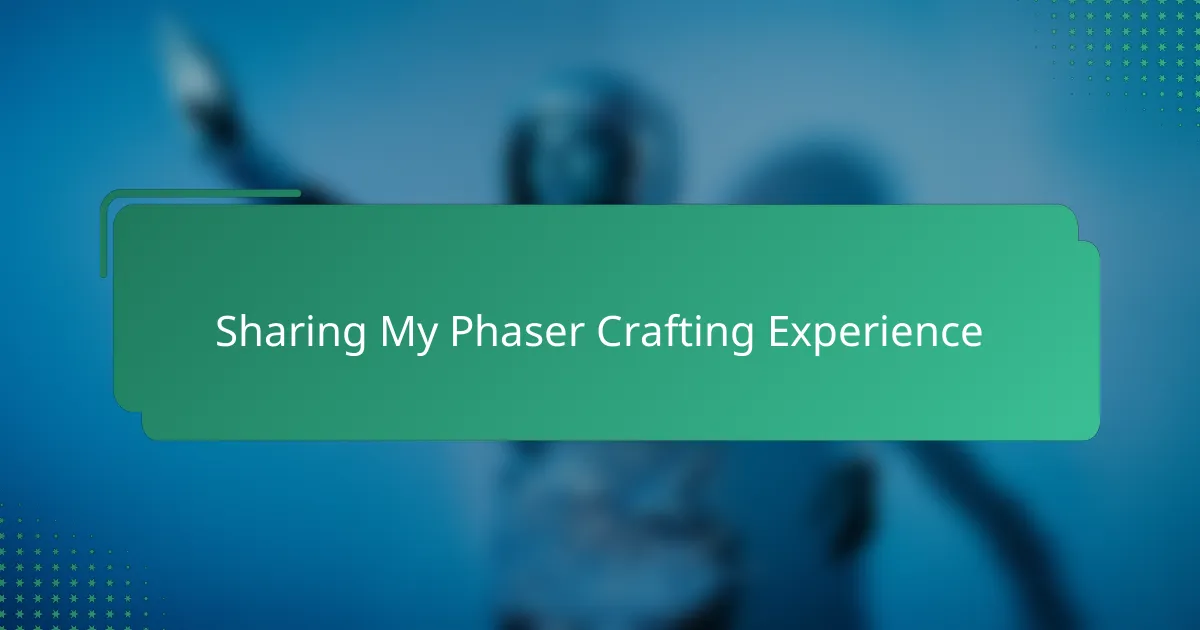
Sharing My Phaser Crafting Experience
Sharing my phaser crafting experience feels like opening a window into a deeply rewarding journey. I remember the excitement and occasional frustration as each piece clicked and fitted together—those moments reminded me why I love turning imagination into tangible art. Have you ever felt that mix of challenge and joy when a vision starts becoming real?
One thing I quickly learned is that patience isn’t just a virtue; it’s a necessity. I spent hours tweaking tiny details, like adjusting button placements or perfecting paint layers, sometimes redoing entire sections just to get that perfect look and feel. It made me appreciate how much dedication a custom prop really demands, but also how satisfying the payoff is when everything finally aligns.
Looking back, what struck me most was how personal the process became. This wasn’t just building a prop—it was about creating a piece of a universe I love, infused with my own touch. When I held the finished phaser, glowing softly under the lights, I felt a connection not just to the fiction, but to my own story as a maker. Have you ever experienced that powerful bond between creator and creation?
